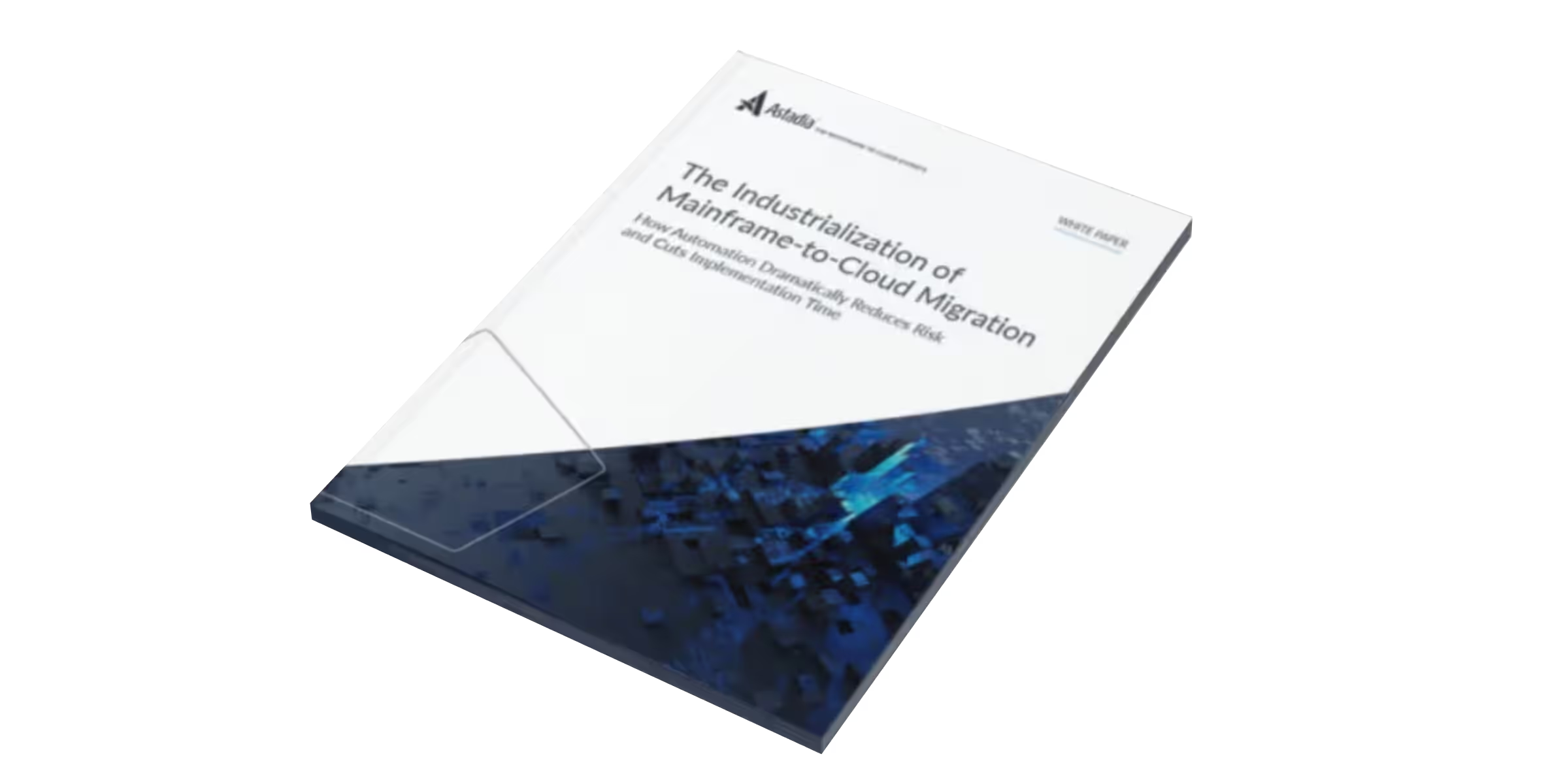IT executives are under pressure to strategically modernize mission-critical systems to stay competitive, drive profitability, and enable innovation. Automation and software intelligence are key factors in successfully migrating legacy applications to the cloud, as well as for enhancing the overall efficiency of ongoing software operations. In a recent webinar hosted in partnership with CAST, Astadia’s CTO, Walter Sweat joined other industry experts to discuss how automation accelerates mainframe modernization and cloud modernization, increases speed to market, and cuts costs. In this article, we’ll summarize some of the key points from the webinar, along with links to help you select the best modernization strategy for your organization.
Key Drivers of Mainframe Modernization
Mainframe modernization is primarily driven by increasing costs, an acute shortage of critical skills, and a pressing need for greater IT agility. As businesses face increasing pressure to innovate and reduce operational costs, the high expense associated with maintaining and running mainframe systems becomes a significant concern. In many cases, it is the ancillary expenses associated with operating mainframe systems that are increasing at the fastest rate.
As seasoned mainframe experts retire, that has led to a critical skills gap, making it difficult for organizations to find and retain personnel with the necessary expertise to manage these complex systems. This shortage is compounded by the stark reality that fewer new professionals are learning mainframe skills, leading to a decline in available talent.
More than ever, though, business agility has become the overriding factor driving mainframe modernization. Traditional mainframe systems lack the flexibility required to quickly adapt to changing business needs and competitive pressures and integrating them with modern technologies can be slow and cumbersome.
Modernizing legacy systems enables organizations to integrate new technologies, streamline operations, and enhance their ability to respond swiftly to market demands. By leveraging cloud computing and other advanced technologies, they can achieve greater scalability, optimize performance, and reduce costs, ultimately driving innovation and maintaining a competitive edge.

Challenges in Mainframe Modernization
Naturally, mainframe modernization is inherently challenging. Legacy code tends to be highly complex and is often poorly documented. Many mainframe systems have been in operation for decades, with applications developed in outdated languages like COBOL and structured in ways that optimized the limited resources available at the time, such as memory and storage.
1. Code complexity and lack of documentation
These applications often include intricate and convoluted code, making it difficult to understand, modify, and migrate to modern platforms. The lack of thorough documentation increases the risk of errors and unforeseen issues during the modernization process.
2. Data migration
Data migration presents a major challenge. Mainframe systems typically handle large volumes of critical business data stored in various formats and structures, such as VSAM files with multiple record types. Migrating this data to a modern environment requires careful planning and execution to ensure data integrity and continuity of business operations. The intricate interdependencies between applications and data also need to be meticulously mapped and managed to avoid disruptions.
Learn more about data migration verification >
3. Lack of mainframe migration expertise
The shortage of skilled mainframe professionals adds further to the difficulty of legacy modernization. As many experienced mainframe experts retire, there is a growing gap in the knowledge and skills required to maintain and transition these systems. Newer generations of IT professionals are less familiar with mainframe technologies, making it challenging to find personnel capable of handling the complexities involved in modernization.
4. Business continuity
Most companies embarking on modernization projects are very concerned about business continuity. Unlike past practices of "big bang" migrations, modern organizations often require incremental approaches to minimize risks and ensure that core business functions remain operational throughout the modernization journey.

Keys to Successful Mainframe Modernization
In the recent Astadia webinar, Walter Sweat, CTO of Astadia offered insights aimed at helping companies understand what their options are, and how to start moving forward with mainframe modernization. Sweat highlighted the importance of developing a comprehensive understanding of the legacy mainframe environment. This includes a detailed inventory of all applications, data, third-party products, and interdependencies.
Accurate and thorough discovery is crucial for identifying potential challenges and planning an effective modernization strategy. This foundational step ensures that organizations have a clear picture of their starting point, which is essential for minimizing risks and avoiding costly surprises during the transition. Automation is another key factor, especially in code conversion, data migration, and exhaustive testing.
Automation not only accelerates the migration timeline but also enhances consistency and vastly reduces human error. With fully automated modernization, organizations can ensure that the migrated applications perform as expected and maintain the same functionality as their legacy counterparts. This approach significantly lowers the risk of disruptions and enhances the overall reliability of the modernization process.
The scalability, flexibility, and cost-effectiveness of the target environment are critical. Post-migration systems must be fully capable of adapting to future business needs, especially as technology evolves. Modern platforms like AWS, Azure, and GCP support operational efficiency and cost-effectiveness, helping enterprises reduce costs by leveraging the inherent advantages of cloud computing. They also provide continuous monitoring and management, high availability and disaster recovery, and security management.

Automation: The Practical Path Forward
Automation is indispensable for mainframe modernization. It facilitates efficient code conversion, robust testing, and scalable infrastructure management, ensuring a smoother, faster, and more reliable transition from legacy systems to modern platforms. By embracing automation, organizations can mitigate risks, optimize performance, and pave the way for ongoing innovation and growth.
Manual conversion of code from languages like COBOL to modern languages such as Java or .NET is prohibitively time-consuming and highly prone to errors. Automated tools streamline this process, allowing for a more seamless and reliable transition. These tools can also be used to support the ongoing maintenance and optimization of the newly modernized systems.
Automated testing frameworks, such as Amdocs’ Ginger, enable comprehensive and efficient validation of the converted applications. This includes running parallel tests to compare the performance and functionality of the legacy and modernized systems, ensuring that the migration has preserved the integrity of the original applications. Automation in testing provides a high level of assurance that the new systems will meet the required standards and perform reliably in a production environment. Generative AI (GenAI) is also growing in importance.
Although it is not yet central to the core conversion processes, GenAI plays a significant role in supplementary areas. Astadia is currently using AI to enhance automation, providing advanced capabilities in areas such as code analysis, optimization, and testing.
Automation, together with an increasingly important GenAI component, plays a pivotal role in achieving the goals of mainframe modernization: reducing costs, improving efficiency, and enhancing agility.
Mainframe modernization is a complex yet essential undertaking for organizations seeking to stay competitive in today’s fast-paced business environment. The insights shared in Astadia’s recent webinar underscore the critical role of automation and software intelligence in this process. By leveraging advanced tools and technologies, businesses can efficiently navigate the challenges associated with legacy systems, ensuring a smooth transition to modern platforms.

Interested in starting a conversation about mainframe modernization for your organization?
Contact the mainframe modernization experts at Astadia today.
Related news
Related white papers:
Let's Talk
Get in touch with our experts and find out how Astadia's range of tools and experience can support your team.
contact us now
.avif)







